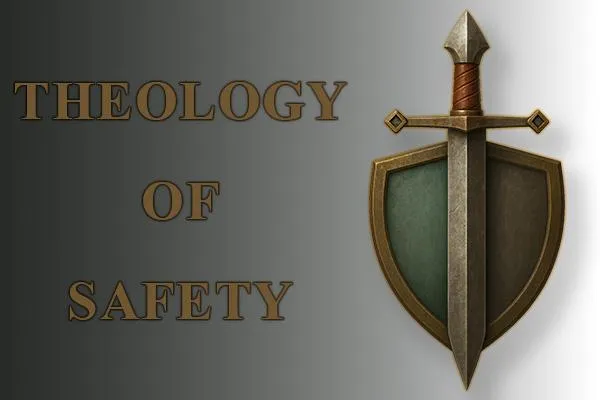
The Theology of Safety

Does Faith in God Mean We Don’t Prepare for Danger?
For many churches, this question sits quietly in the background until something happens—a disruption, a medical emergency, a moment of confusion that reminds us how fragile safety can be.
But Scripture never teaches that faith equals passivity. In fact, biblical faith is active, responsible, and deeply protective. Preparation isn’t a lack of trust—it’s the evidence of it.
When we take the time to train our people, write our plans, and prepare our teams, we’re not acting out of fear. We’re living out a calling.
That’s the heart of the theology of safety—seeing protection as a form of discipleship, and preparedness as an expression of obedience.
The Biblical Foundations of Safety
Throughout Scripture, God calls His people to watch, guard, and care for one another. This isn’t militaristic—it’s ministerial. Safety begins as stewardship.
Stewardship and Wisdom
“The prudent sees danger and hides himself, but the simple go on and suffer for it.” — Proverbs 27:12 (ESV)
Prudence—seeing danger and acting wisely—isn’t paranoia; it’s biblical obedience. Stewardship isn’t only about money; it’s about managing what God entrusts to us, including His people.
Leadership Accountability
“I am the good shepherd. The good shepherd lays down his life for the sheep.” — John 10:11
Church leaders have a spiritual responsibility to protect their flocks. Safety, in this sense, is pastoral—it reflects the same selfless care Christ modeled for us.
The Example of Nehemiah
When Nehemiah rebuilt Jerusalem’s wall, he didn’t just pray; he planned. He stationed guards, organized workers, and built with one hand while holding a weapon with the other. His vigilance didn’t signal doubt in God—it demonstrated disciplined faith.
Caring for Others
“Let each of you look not only to his own interests, but also to the interests of others.” — Philippians 2:4
Caring for the physical safety of others is one of the simplest expressions of love. A church that prepares to protect is living out the gospel’s command to look to the interests of others.
The Balance Between Faith and Preparedness
Some believers fear that preparing for threats might show a lack of trust in God. But faith and preparedness are not opposites—they are allies.
When Joseph prepared Egypt for famine, he wasn’t doubting God’s provision. He was obeying God’s warning. Preparation is what faith looks like in motion.
In today’s context, that means developing response plans, conducting drills, and training our teams to respond calmly under pressure.
We call that faith-informed readiness—an intentional, biblically aligned approach to safety that allows the church to keep its doors open and its ministry strong, no matter the crisis.
Safety as Ministry
Safety work in the church is not enforcement—it’s service. Every usher, greeter, and safety team member is a minister of presence, peace, and protection.
When done correctly, safety efforts enhance hospitality instead of hindering it. They protect the sanctity of worship, the emotional well-being of the congregation, and the continuity of the church’s mission.
“Safety is a ministry of presence, peace, and protection.”
When volunteers are trained to de-escalate conflict, offer help with calm confidence, and communicate with compassion, they are doing ministry—pure and simple.
Practical Theology: Turning Faith Into Action
True theology always leads to action. The theology of safety calls for more than belief—it calls for structure, planning, and skill.
A church that takes safety seriously:
Has written plans and clear policies.
Trains its volunteers consistently.
Communicates effectively during emergencies.
Partners with law enforcement and insurance providers to reduce risk.
That’s where the Comprehensive Church Safety Team Training (CCSTT) comes in.
Built by a former law-enforcement negotiator and faith-based crisis instructor, CCSTT helps churches turn good intentions into a mission-ready ministry—organized, equipped, and spiritually grounded.
Prepare your people. Protect your house. Honor your calling.
Theological Confidence in Action
God’s people have always balanced faith and responsibility. We pray and prepare. We trust and train.
The theology of safety is not about fear—it’s about stewardship. It’s about using wisdom, foresight, and courage to care for what God has given us.
Churches that embrace this mindset are not reacting to danger; they are fulfilling a calling. Because protecting the congregation is not just policy—it’s discipleship.
Ready to live out your theology of safety?
Download the Church Safety Readiness Checklist or explore how the CCSTT can help your church turn faith into action.
Download Now Readiness Checklist
External Links:
Faith-Based Security Network (FBSN) https://www.fbsnamerica.com/
Faith-Based Security Advisory Council (DHS) https://www.dhs.gov/faith-based-security-advisory-council
DHS Center for Faith / Faith-based community resources https://www.dhs.gov/faith
DHS NGO Faith-Based Resource Guide https://www.dhs.gov/sites/default/files/2024-12/24_1119_ope_Non-governmental-Organizations-%28NGO%29-Faith-Based-Resource-Guide.pdf
CISA “Protecting Houses of Worship” (faith-based security resources) https://www.cisa.gov/topics/physical-security/protecting-houses-worship
